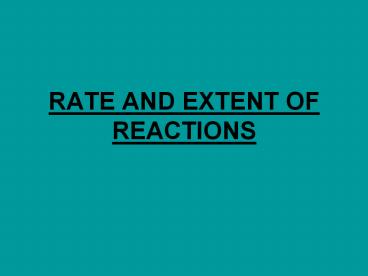RATE AND EXTENT OF REACTIONS - PowerPoint PPT Presentation
1 / 7
Title:
RATE AND EXTENT OF REACTIONS
Description:
RATE AND EXTENT OF REACTIONS RATE AND EXTENT OF REACTIONS Rates or reactions (reaction kinetics) - The rate at which something occurs is an indication of the change ... – PowerPoint PPT presentation
Number of Views:100
Avg rating:3.0/5.0
Title: RATE AND EXTENT OF REACTIONS
1
RATE AND EXTENT OF REACTIONS
2
- Rates or reactions (reaction kinetics)
- - The rate at which something occurs is an
indication of the change of that particular - entity per unit time (how fast or slow
something is) - - The reaction rate is the change in the
CONCENTRATION of the reactants and products - PER UNIT TIME (unit mol.dm-3.s-1)
- During a reaction
- Reactants ? Products
- - the concentration of the reactants will
decrease, while that of the products increase - - The average speed of a reaction can be found
by considering the change in the - concentration of the reactants or products
3
Collision theory - Reactions occur when 2/more
reactant particles collide to form product
particles - As a result of collisions, bonds can
be broken and atoms in the particles rearranged -
The more collisions per second, the faster the
reaction - Not all collisions result in a
reaction, only effective collisions - Factors
that need to be considered 1) Correct
orientation of molecules 2) Energy of the
molecule - Not all molecules, in a
mixture at a specific temperature will have
enough KE to break bonds on collision
with other particles - Distribution of
the KE of the molecules in a mixture is given by
the following - No molecules with zero
KE - Always a fraction of molecules
with very high KE - The peak indicates the
most probable energy of most
molecules - The area below the curve gives
the total number of molecules in the
system
4
- - For a reaction to occur, the molecules must
have more energy than the activation energy - EA Minimum Kinetic energy needed to let the
reaction occur - Summary of collision theory
- 5 Factors that influence the reaction rate and
collision theory - 1) The nature of the reactants
- - The strength of the bonds between
reactant molecules differ - - Thus the activation energy is related to
bond strength - 2) Concentration
- - If the concentration of the reactants is
increased - - There are more particles present
- - Thus more reactions take place per
second - - Thus a higher proportion of
collisions have KE greater than the activation
energy
http//www.youtube.com/watch?vkjKyEdrVXJAfeature
related
http//www.youtube.com/watch?vJQdlQAwlTtgfeature
related
http//www.youtube.com/watch?vt0xl0CXjB04
5
5) Adding a catalyst - A catalyst (a
substance that influences the rate of the
reaction without undergoing any permanent
change itself or being used up) is known as a
positive catalyst - A catalyst provides an
alternative (lower activation energy) route for
the reaction - It does this by providing a
new mechanism for the reactants to bond -
Catalysts can be solids, liquids or gasses
6
(No Transcript)
7
Measuring the reaction rate - There are
different methods to enable us to calculate the
reaction rate - The method chosen, depends on
the properties of the particular reaction - For
example, when a gas is formed (product), the rate
of gas formation can be calculated by
considering the change in the volume of gas -
Some reactions form products that change colour
and the strength or intensity of the colour
can be measured with a spectrophotometer - Other
reactions form precipitates that can be measured
Since there are various factors that influence
the reaction rate, when investigating one factor,
the rest must be kept constant!
NOTE































